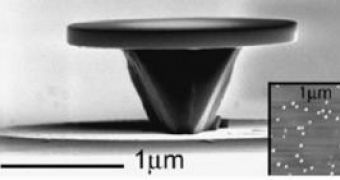LASER - Light Amplification by Stimulated Emission of Radiation. It's a combined quantum-mechanical and thermodynamical process, a light source with various properties that emits light in a narrow and well-defined beam and with a well-defined wavelength (or color).
There are some constraints, however, regarding how small a laser can get.
The typical laser has a vast number of emitters - electronic transitions in an extended crystal, for example - confined within an optical cavity. Light trapped and reflecting back and forth in the cavity triggers the cascade of coherent, laser light. But about a decade ago, researchers made the first quantum dot laser.
A quantum dot is a semiconductor nanostructure that confines the motion of conduction band electrons, valence band holes, or excitons (bound pairs of conduction band electrons and valence band holes) in all three spatial directions, and has a discrete quantized energy spectrum.
A NIST-Stanford-Northwestern team made "microdisk" lasers by layering indium arsenide on top of gallium arsenide. The difference between the different-sized atomic lattices forms indium arsenide islands, about 25 nanometers across, that act as quantum dots. The physicists then etched out disks, 1.8 micrometers across and containing about 130 quantum dots, sitting atop gallium arsenide pillars.
The disks are sized to create a "whispering gallery" effect in which infrared light at about 900 nanometers circulates around the disk's rim. That resonant region contains about 60 quantum dots, and can act as a laser. It can be stimulated by using light at a non-resonant frequency to trigger emission of light.
But the quantum dots are not all identical. Variations from one dot to another mean that their emission frequencies are slightly different, and also change slightly with temperature as they expand or contract. At any one time, the researchers report, at most one quantum dot - and quite possibly none - has its characteristic frequency matching that of the optical resonance.
As they varied a disk's temperature from less than 10K to 50K, the researchers always observed laser emission, although they needed to supply different amounts of energy to turn it on. At all temperatures, they say, some quantum dots have frequencies close enough to the disk's resonance that laser action will happen.
But at certain temperatures, the frequency of a single dot coincided exactly with the disk's resonance, and the laser emission then needed only the smallest stimulation. It's not quite a single-dot laser, but it's a case where one quantum dot effectively runs the show.
Quantum-dot lasers have possible applications as embedded communication devices not only for their small size, but because they switch on with far less power than even the solid-state lasers used in DVD players.

 14 DAY TRIAL //
14 DAY TRIAL //